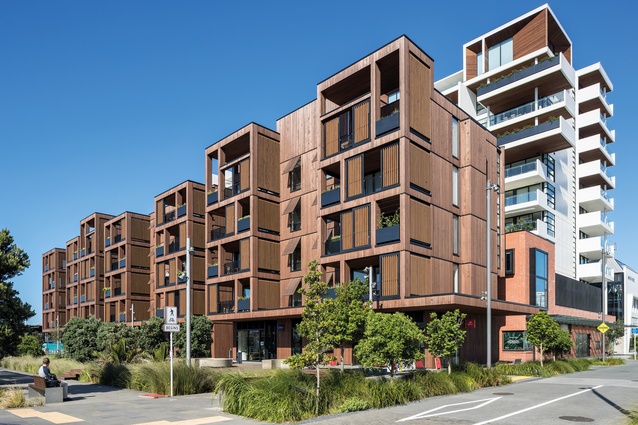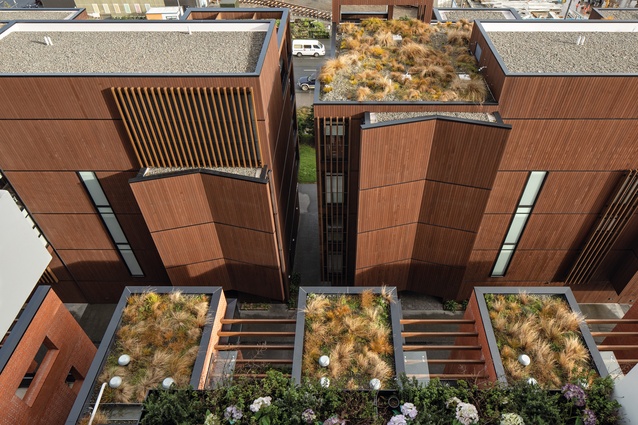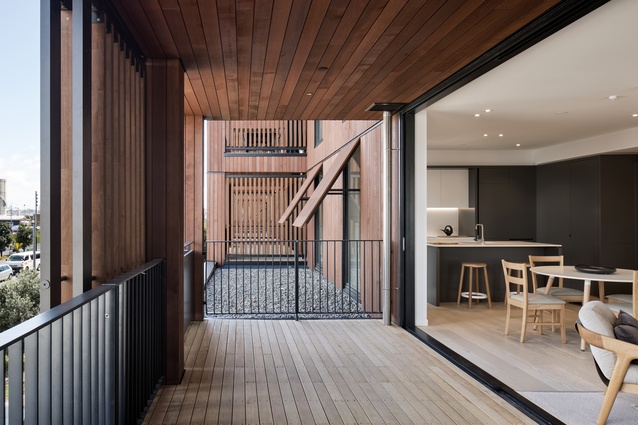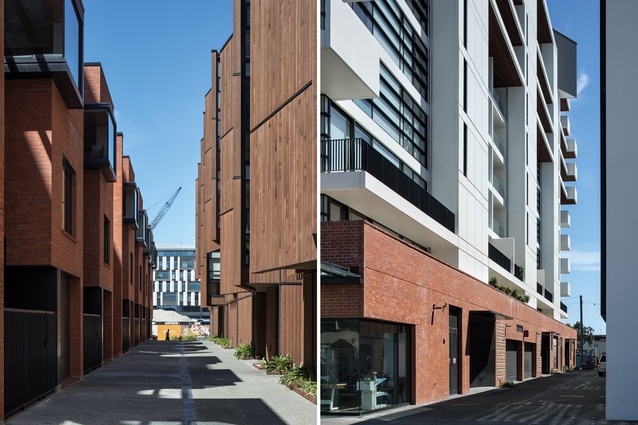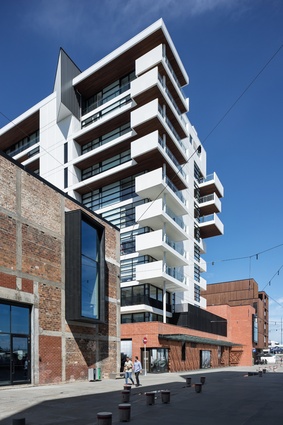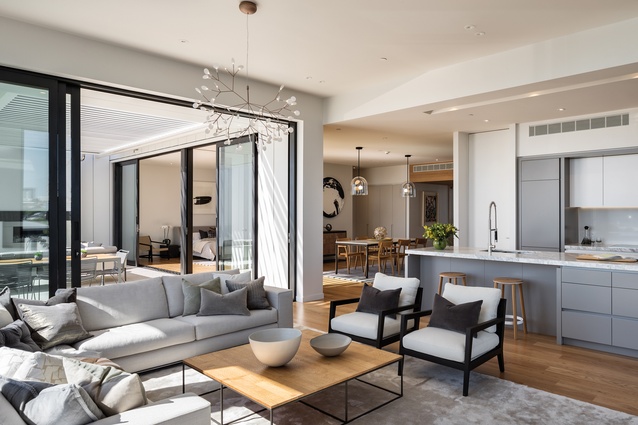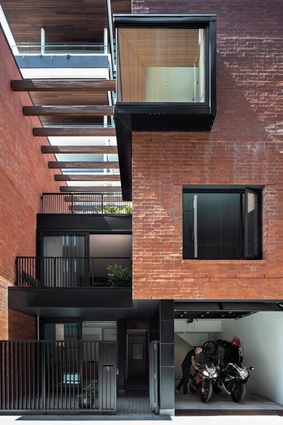Happily mewed up: Wynyard Central
Chris Barton explores the Architectus way as seen in its radical arrangement of apartment types at the heart of this waterfront development, which received the Sir Ian Athfield Award for housing at the 2019 New Zealand Architecture Awards.
When Architectus began design work on 113 apartments in Auckland’s Wynyard Quarter on a block known as Wynyard Central East 2, Parcel 4 (E2 for short), Mark McGuinness, managing director of developer Willis Bond, threw something of a curve ball. He asked: “What if you put the bigger piece of building to the eastern side of the site and it looked across some lower buildings to Daldy Street? Would there be any benefit in that?”
The question surprised because it went against the reference designs that Architectus had proposed in its masterplan, begun in 2005, for the entire precinct. That envisaged perimeter blocks for various zoned parcels of land created by the street grid. The aim was “to bring the outside in, connect to spaces and uses within the wider waterfront precinct and to form neighbourhoods within neighbourhoods, in the themes of green, gritty and blue”. The result would be a precinct “with many layers, integrated yet flexible”.
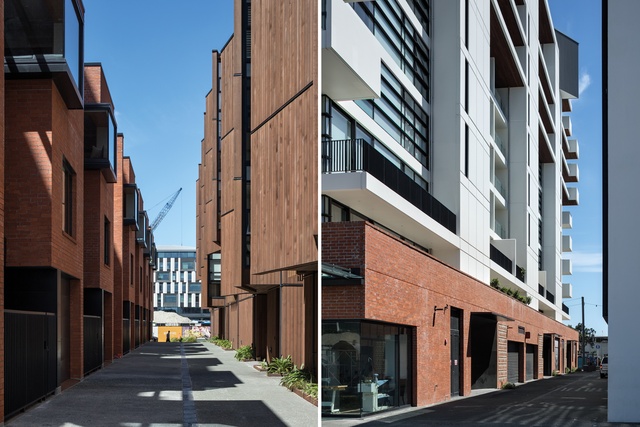
Architectus principal Patrick Clifford points out the default urban design position would probably have placed the tallest piece of building onto the Daldy Street edge of the E2 site where the firm, as part of its masterplanning, had designed a linear park. Just for the hell of it, the 2014 NZIA Gold Medal recipient decided to explore the opposite “what if?” configuration. “We thought: ‘What if you made these buildings on the park lower and of a smaller footprint with lanes in between?’ We also figured out, even though it seemed a little unusual, we could put some mews houses in between.”
Unusual indeed. Mews is a British name for a row or courtyard of stables and carriage houses with living quarters above them – often built behind large city houses, before motor vehicles, to cater for the horses, coachmen and stable-servants of prosperous residents. The word derives from the French muer, ‘to moult’, reflecting its original function – to confine hawks while they moulted. Shakespeare shows how the word is used in The Taming of the Shrew: “Why will you mew her up, Signior Baptista?” – meaning to confine, coop up or shut up in.
The arrival of this quaint English housing form amongst the swathes of apartment blocks proposed for Wynyard Quarter seems bizarre and quite why it entered Clifford’s thinking is unclear. But, in many ways, the mews are E2’s finest hour. The eight, three-storeyed brick oddities disrupt expectations of inner-city living and provide much-needed variation to the repetitive, blocky new apartment and office buildings of the area.
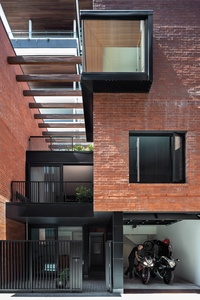
Sitting in a single row beside Puanga Lane and in between two apartment towers – 11 levels behind backing onto Mahuru Lane and five levels in front facing Daldy Street – they bring a suburban scale and a more diverse ground plane allowing the public domain to penetrate the site’s centre. True to form, the 130m2 mews (including roof deck/courtyard/balcony areas of 35m2), which were marketed as townhouses, offer inverted living: the top-level getting sun for much of the day on its roof-deck courtyard, which adjoins a kitchen-dining space featuring a corner window seat protruding into the lane and garnering a northern outlook.
The second level has a living room with balcony beside a master bedroom. The ground-floor level provides a coveted drive-in garage and adjacent bedroom/study space. All the mews rooms look out to the middle Puanga Lane – a view that’s entirely of the back of the cedar-clad five-storeyed ‘pavilion’ apartments facing Daldy Street. The proximity of multiple neighbours is also evident looking up from the roof deck to the 11-level ‘artisan’ apartment block behind. Far from feeling mewed up or shut up in, the effect is strangely comforting: an enveloping containment by day-to-day living all around.
The mews’s Puanga Lane also provides the entries to the pavilion apartments, divided into three discrete blocks separated by two lanes joining Puanga Lane to Daldy Street. Typical pavilion apartments range from 47m2 to 95m2, including 11m2 and 17m2 balconies respectively, plus a few larger units of 135m2. Access from the mews side means the activity of the perimeter of ground-level retail spaces, including a barber, a tailor, a Pilates gym and a range of food and beverage outlets, is uninterrupted by apartment entries.
On the Daldy Street face, the retail spaces are sheltered by a generous verandah engaging with the adjacent linear park and formed by the pavilion apartments cantilevering over the footpath. From the apartments, wide balconies – semi-enclosed with sliding timber screens: in effect, outside rooms – put the residents into the hubbub of the street and the retail activity below, giving a sense of community belonging. The cedar cladding is beautifully finished, adding a warm atmosphere and a sense of craft.
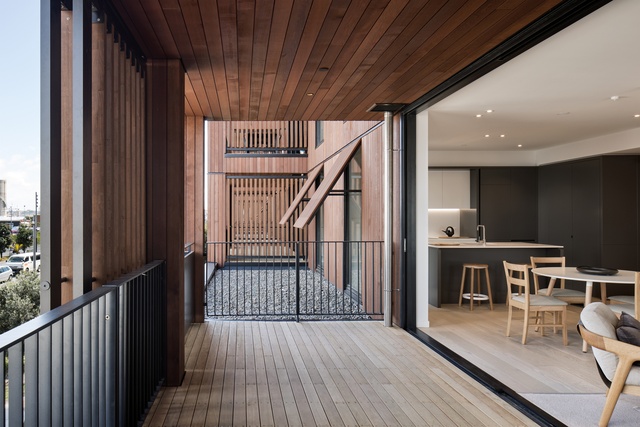
Here, the confinement of apartment living busts out into the park, the street and the western sun but, also, all around, thanks to careful articulation of the pavilion façades and windows. The result is many small views – up, down and oblique – and a sense of connection, primarily to Daldy Street Park and the mews’s Puanga Lane, but also to the adjoining lanes and, for the corner units, to either Pakenham Street or the newly landscaped Tiramarama Way.
Considerable care is taken to ensure all these apartments enjoy natural light and views, not just to look beyond their confines but, also, for passive environmental control. Combined with a variety of sustainability technologies, the result is a 7-star Homestar rating overall and 8-star for 80 per cent, meaning all apartments require no artificial heating or cooling for 80 per cent of the year and no artificial lighting in living spaces for 80 per cent of annual daylight hours.
The muscular, concrete, so-called artisan apartment block is notable for its three vertical circulation cores, providing access from the rear Mahuru Lane and for its dual-aspect (west and east) through apartments of between 110m2 and 135m2, including 30m2 balconies. As with the pavilion apartments, the artisan apartment balconies are covered, designed to offer some privacy and to be used as outdoor rooms even when the Auckland weather is not ideal. As well as the through apartments, the 11-level block also offers smaller units of between 54m2 and 65m2, more spacious 150m2 units on levels 8, 9 and 10; and four at the penthouse level of 225m2 with balconies and courtyards of 20m2 to 50m2.
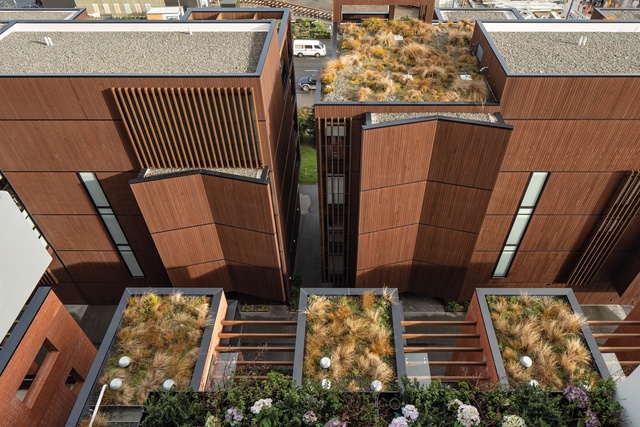
Looking down from the artisan apartment balconies gives a sense of the rigorous logic of the Architectus grand design – the lanes and the coded material palette of timber for the pavilions, brick for the mews and concrete for the artisan apartments. There’s also the clever way the brick mews provide a frontage to the lower three levels of the apartments to mask the carparking.
But the unusual aspect here is the green roof landscaping of the mews and pavilions undertaken in association with Panuku Development Auckland and its Iwi Liaison Group. A variety of brownish-yellow native sedge grasses (carex testacea and buchananii), tangled orange-brown and lime-green spreading coprosmas (mangatangi and acerosa), dwarf blue tussock (festuca coxii) and fern-like ground cover (leptinella dioica) combines to produce an other-worldly roofscape that foregrounds a familiar outlook across Westhaven and to the Harbour Bridge. Planting that’s echoed in planter boxes on the balconies and in the lane and reflects the flora once here long ago.
The elevated landscape in the city is startling. Perhaps a gentle reminder that, although these top-class, expensive apartments sold with 125-year prepaid ground leases to emulate freehold title are clearly built to last, they are on low-lying reclaimed land, prone to the effects of climate change. Then again, they might just be pretty roofs.
This article first appeared in Architecture New Zealand magazine.


